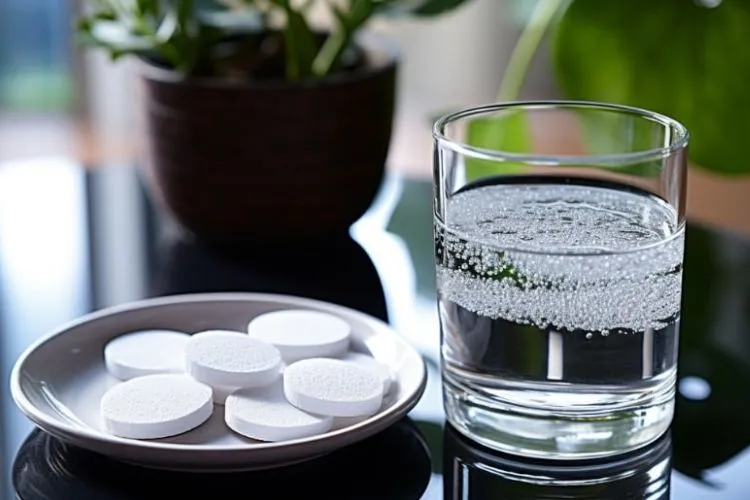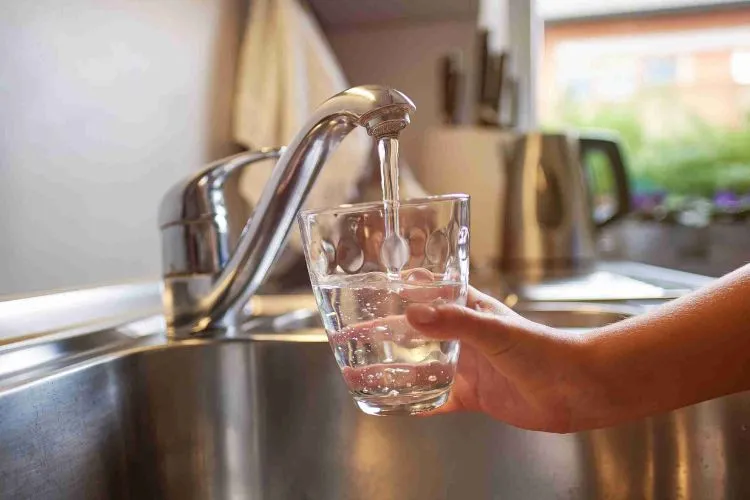Chlorine is a common chemical used in tap water as a disinfectant. While it plays a crucial role in eliminating pathogens, there are situations where dechlorinating water becomes necessary.
Aquarium enthusiasts, gardeners, and individuals sensitive to chlorine might need water without it.
That’s why it becomes important to know how long does it take to dechlorinate water?
This article aims to explore multiple ways to dechlorinate water naturally and through various methods.

💦 What is Chlorine and Its Purpose in Water Supply?
Chlorine is a chemical added to water supplies to kill harmful bacteria and viruses. It has played a significant role in improving public health by reducing waterborne diseases.
Despite its benefits, the taste, smell, and potential health risks of chlorine have led many to seek water dechlorination solutions.
💦 Why Dechlorinate Water?
Dechlorination is vital for a few reasons. Aquariums require it to protect the fragile ecosystems within. Some people prefer the taste of water without chlorine.
Also, chlorine can harm plants, making dechlorinated water better for gardening. Moreover, individuals with chlorine sensitivity due to health conditions benefit from chlorine-free water.
💦 How Long Does It Take to Dechlorinate Water?
When left to stand, chlorine will naturally evaporate from water. This process can take up to 24 hours.
However, the exact time varies based on factors like water surface area, temperature, and the initial amount of chlorine. More surface area and warmer temperatures can speed up dechlorination.
💦 Methods of Dechlorination

Several methods allow for faster or more controlled dechlorination.
Boiling
Boiling is a simple method. Heating water to a rolling boil for about 15 to 20 minutes can remove chlorine. This method is straightforward but not always energy-efficient or practical for large quantities of water.
UV Exposure
UV light from the sun can break down chlorine. Leaving water in direct sunlight for 24 hours significantly reduces chlorine levels.
However, this method depends heavily on weather conditions and availability of sunlight.
Chemical Neutralization
Chemical additives like sodium thiosulfate can neutralize chlorine instantly. This method is efficient, but handling chemicals requires care to avoid adverse reactions or residue in the water.
Activated Carbon Filtration
Activated carbon filters remove chlorine as water passes through. These filters are effective and can provide dechlorinated water on demand. The time it takes depends on the water flow rate and filter size.
Vitamin C Dechlorination
Vitamin C is a less known but effective dechlorination method. Adding a small amount of ascorbic acid can neutralize chlorine almost instantly. This method is safe and leaves no harmful residues.
💦 Factors Affecting Dechlorination Time
The time it takes to dechlorinate water can vary. Factors include the initial chlorine concentration, water temperature, and pH levels.
Efficient mixing and sufficient contact time with dechlorinating agents or filters also play crucial roles.
💦 Pro Tips for Effective Dechlorination
For natural dechlorination, using containers with wide openings can speed up the process. When boiling water, ensure safety and consider energy costs.
If using chemical treatments, follow instructions carefully to prevent overdosing. Testing water with a suitable test kit after dechlorination ensures accuracy and safety.

💦 Safety Considerations
Safety is paramount when dechlorinating water. Exercise caution when boiling water to prevent accidents.
When using chemical neutralizers, handle them with care to avoid skin contact or inhalation. Always follow manufacturer’s guidelines for using filters or additives.
💦 Environmental Considerations and Chlorine
Chlorine’s reactivity isn’t limited to pathogens; it can also negatively impact the environment. When discharged into waterways without adequate treatment, chlorine reacts with organic matter forming toxic byproducts that can be detrimental to aquatic ecosystems.
For example, these compounds affect fish and other wildlife, potentially disrupting reproductive processes and even leading to large-scale die-offs.
Proper dechlorination processes before water discharge are crucial to prevent such ecological damage and ensure the integrity of natural habitats.
💦 Case Studies of Dechlorination in Practice
In various parts of the world, innovative dechlorination practices have been successfully implemented to address local needs and challenges.
For instance, a municipal water treatment facility in California adopted activated carbon filtration to remove chlorine from water before it reached natural waterways, protecting local aquatic life.
Another example is a public aquarium that employed vitamin C dechlorination to ensure the health and longevity of its marine inhabitants, showcasing its effectiveness in delicate ecosystems.
Additionally, a community in Japan utilized UV exposure in a community garden project, safeguarding plant health by efficiently reducing chlorine levels in irrigation water.
These examples underscore the adaptability and efficiency of different dechlorination methods in diverse applications, highlighting their critical role in maintaining ecological balance and catering to specific health and environmental objectives.
💦 Frequently Asked Questions (FAQs)
How can I test if my water is fully dechlorinated?
Water test strips designed to measure chlorine levels can accurately gauge dechlorination. They are available at most pet stores or online.
Does colder water take longer to dechlorinate?
Yes, colder water slows down the evaporation of chlorine. Warm temperatures speed up the process.
Can I use dechlorinated water for drinking?
Yes, dechlorinated water is safe for drinking, especially if you prefer water without the taste or smell of chlorine.
Are there differences between the dechlorination time for chloramine and chlorine?
Yes, chloramine, a combination of chlorine and ammonia, is more stable and harder to remove than chlorine. Some methods, like boiling or UV exposure, may not be as effective against chloramine.
What are the environmental impacts of dechlorinating water?
Properly dechlorinated water poses minimal environmental risks. However, disposing of chemical neutralizers requires care to avoid harm to waterways or soil.
Conclusion:
Dechlorinating water is essential for various applications, from aquarium keeping to addressing personal health concerns.
The time it takes can range from instant to 24 hours, depending on the method used.
By understanding the available methods and their considerations, you can choose the most suitable option for your needs.

Devon Shorts, a seasoned expert with over a decade of experience in water safety, shares valuable insights on this blog “Aqua Safety Plus”. Trust his expertise to keep your water clean and your family safe.
